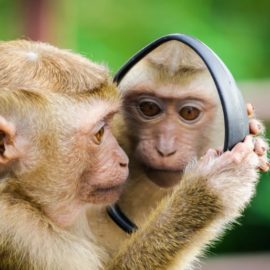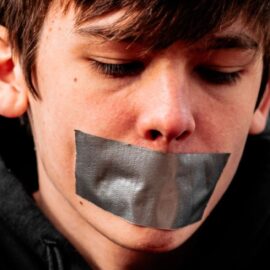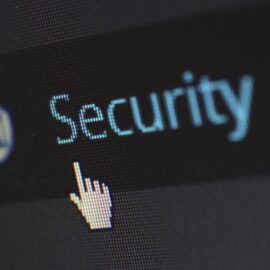

This article is an excerpt from the Shortform book guide to "Cues" by Vanessa Van Edwards. Shortform has the world's best summaries and analyses of books you should be reading.
Like this article? Sign up for a free trial here.
Do you have charisma—or anti-charisma? What subtle cues might be sabotaging your charm without you even realizing it?
In Cues: Master the Secret Language of Charismatic Communication, Vanessa Van Edwards lays out the concept of anti-charisma. She identifies several verbal and nonverbal signals that can undermine your charm and offers practical alternatives to enhance your presence.
Keep reading to explore the world of anti-charisma and discover how to become a more magnetic communicator.
Anti-Charisma Cues
In her book, Van Edwards discusses cues you should use to cultivate charisma. Then she turns to several anti-charisma cues you should mitigate or avoid. We’ll describe the cues that signal contemptibility—the absence of warmth and competence—and provide alternatives you can use to minimize contemptibility. Finally, we’ll discuss how to counter others’ biases, which could lead them to unfairly perceive you as uncharismatic.
Contemptible cues counteract charisma by decreasing your perceived warmth, competence, or both, leading others to dismiss you. Just like charismatic cues, these anti-charisma cues fall into two categories: verbal and nonverbal.
Verbal Cues
#1: Asking questions when you mean to make a statement. Van Edwards says that many people raise their pitch at the end of a sentence—this variation in pitch is known as question inflection, and it signals that you’re unsure of what you’re saying. To project competence instead, maintain a steady pitch throughout your sentence. (Shortform note: You can use the inverse of this rule when it’s important to project warmth: For example, question inflection (also known as “upspeak” or “uptalk”) can help soften criticism or make an instruction seem like a suggestion. This can be helpful when you want to signal that you’re not trying to overpower someone, like when you disagree with your boss or a friend.)
#2: Uninteresting and pessimistic language. Van Edwards says when your words have uninteresting or pessimistic connotations, your audience feels uninterested and pessimistic. Because people avoid others who make them feel negative emotions, your audience will avoid interacting with you when you use such language. So opt for more interesting alternatives to banal language, and replace negatives with positives whenever possible. For example, instead of saying, “I hope our trip isn’t boring,” use the positive inverse of the same statement: “I hope our trip is exciting!”
(Shortform note: Although Van Edwards is primarily concerned with the way you talk to others, you may also be able to enhance your charisma by choosing positive and engaging language in your self-talk. Many people use harsher or more apathetic language with themselves than they’d use with others, and over time, this can make you feel more stressed, less confident, and even depressed. Outwardly, this might make you seem like a negative person, which Van Edwards notes can drive others away. To correct negative self-talk, experts suggest that you lean into humor, gratitude, and self-compassion.)
Nonverbal Cues
#1: Defensive body language. Defensive body language includes protective poses such as crossing your arms as well as two other behaviors: covering your mouth and blocking your vision. The facepalm is one notable example of defensive body language—it suggests that you’re feeling embarrassment (or secondhand embarrassment) and need to take a moment to recover. Defensive body language signals discomfort, shock, shame, or fear, so using it makes others feel anxious. (Shortform note: Other forms of defensive body language to avoid include covering vulnerable body parts like your throat, tensing your muscles, and curling up or shrinking to make yourself smaller.)
#2: Negative facial expressions. Many people unknowingly show facial expressions that signal sadness, irritation, and contempt—like knitted eyebrows, pursed lips, smirks, and frowns—even when they don’t actually feel those emotions. To avoid having others misinterpret your emotions, Van Edwards encourages you to be mindful of your facial expressions at all times. (Shortform note: If you’re prone to showing negative facial expressions, you might have what some experts refer to as “resting bitch face” or RBF. Some people with RBF reportedly seek plastic surgery to counteract it; according to Van Edwards’s website, some less dire solutions include smiling more and using makeup and accessories to appear more cheerful.)
#3: Self-soothing gestures. These are small, compulsive, self-focused gestures like fidgeting with your keys, bouncing your leg, or peeling off your nail polish. You may only exhibit these behaviors out of habit, but they’re off-putting because they make you seem stressed and lacking in self-control. To prevent self-soothing, Van Edwards suggests preoccupying yourself by giving your hands or legs and feet something more natural and purposeful to do. For example, if you want to stop fidgeting with your keys in class, you could take notes or even doodle instead.
(Shortform note: Although Van Edwards warns against self-soothing behaviors, other experts say that they can have benefits. For example, some studies suggest that some self-soothing behaviors, like pacing and doodling, can improve focus and help guard against the risks associated with a sedentary lifestyle. Additionally, some children (and adults) find that self-soothing with fidget toys helps them overcome symptoms of anxiety, ADHD, and autism.)
Confirming Unconscious Biases
Van Edwards points out that others may have unconscious biases against you because they unconsciously subscribe to certain stereotypes. For example, if you’re a Black woman, you may encounter the “angry Black woman” stereotype, which makes others perceive you as overly hostile or aggressive regardless of your actual demeanor and behavior. Van Edwards says that, even though it’s unfair for the responsibility of counteracting these stereotypes to fall on you, it may benefit you to purposefully counteract them anyway. If you’re concerned about how being perceived as an angry Black woman could harm your career, for example, you could employ extra warmth cues during workplace disagreements to protect your professional image.
(Shortform note: Social scientists refer to the pressure to avoid confirming others’ unconscious biases as stereotype threat. Stereotype threats often induce anxiety and distract you from the task at hand, since you become concerned with both performing in the moment and counteracting the stereotype in question. Because of this, stereotype threats can cause you to perform worse than you would if you weren’t thinking about the stereotype in question. If you’re facing a stereotype threat, one strategy that could help you overcome it is self-affirmation. Studies suggest that when you bring to mind things you like about yourself or your inherent value as a person, you reduce the power a stereotype threat holds over you in the moment.)
Exercise
- Are there any anti-charisma cues that you need to mitigate or avoid in your personal life? For example, maybe you naturally cross your arms a lot and need to be vigilant about signaling openness on your first date.
- Are there any anti-charisma cues that you need to mitigate or avoid in your professional life? For example, maybe you tend to use self-soothing gestures like nail-biting when you’re nervous, and you want to avoid those gestures so you appear more confident during your performance review.

———End of Preview———
Like what you just read? Read the rest of the world's best book summary and analysis of Vanessa Van Edwards's "Cues" at Shortform.
Here's what you'll find in our full Cues summary:
- Which verbal and nonverbal cues will make you more charismatic
- How to make yourself seen in your professional and social lives
- Why head tilts are cuter in dogs than in humans






